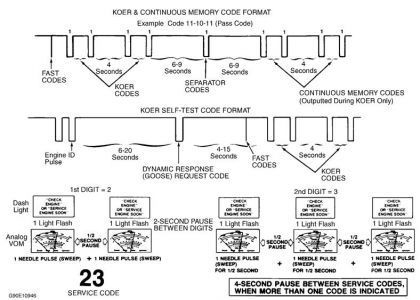Hello .. thanks for the donation .. much appreciated
Frst thing we need to do is find out what codes the CEL/PCM is displaying when the fault occurs follow the procedures below and let me know !!
RETRIEVING CODES
Service codes are retrieved from the EEC-IV system through the self-test connector. Various methods and test equipment may be used to access these codes. The following test equipment may be used:
Analog Volt-Ohmmeter (VOM)
"Scan" Tool
STAR Series Tester
In-Dash "CHECK ENGINE" or "SERVICE ENGINE SOON" Light
SELF-TEST CONNECTOR LOCATIONS
ApplicationLocation
AerostarLeft front inner fender panel
Explorer, Navajo & RangerRight front inner fender panel
READING CODES
KOEO & KOER SELF-TEST CODES
All service codes are 2 or 3-digit numbers. Codes are outputted, one digit at a time, by ECA. See appropriate chart under CODE-TO-TEST MENU(S) for definitions of codes. These codes indicate current faults in the system, and should be serviced in the order of appearance. Use appropriate chart under CODE-TO-TEST MENU(S) to find the correct CIRCUIT TEST. Codes are shown as voltage pulses (needle sweeps) on an analog Volt/Ohmmeter (VOM). See Fig. 1 .
If using VOM, pay careful attention to the length of pauses in order to read codes correctly. There is a 1/2-second pause between number of sweeps in a digit, and a 2-second pause between the digits in a code. There is a 4-second pause between each code. KOEO codes are separated from Continuous Memory codes by a 6-second delay, a single 1/2-second sweep (Separator) and another 6-second delay. Record codes in the order received.
If using "Scan" Tool, it will count the pulses and display them as a digital code. The STAR Series Tester will add a zero (0) to single-digit Separator Code (10) and Dynamic Response Code (10). The Dynamic Response Code is displayed in KOER SELF-TEST. See Fig. 1 . If using "CHECK ENGINE" light, service codes are displayed as flashes.
SEPARATOR PULSE
A single 1/2-second separator pulse is issued 6-9 seconds after last KOEO code. Then 6-9 seconds after the single 1/2-second separator pulse, Continuous Memory Codes (soft faults) are displayed. Some digital test equipment may display the separator code as a 10 instead of a 1.
PASS CODES
A Code 11 or 111 indicates there are no service codes recorded in that portion of the test, and system passes that portion of the test. If Code 11 or 111 is not received in KOEO SELF-TEST, codes received during KOER SELF-TEST may not be valid. It is very important that Code 11 or 111 (pass code) be observed in KOEO SELF-TEST. A Code 11-1-11 or 111-1-111 output during KOEO SELF-TEST indicates there is no KOEO code or Continuous Memory Code recorded. The separator code may appear as a 10 instead of a 1 on some test equipment.
CONTINUOUS MEMORY CODES
These codes result from information stored by ECA during continuous self-test monitoring. Codes are displayed in KOEO SELF-TEST, after separator pulse code. Use these codes for diagnosis ONLY when KOEO SELF-TEST and KOER SELF-TEST result in Code 11 or 111 (pass code), and all steps under QUICK TEST are successfully completed. (There are few exceptions which may be checked after KOEO codes have been repaired). These codes indicate faults recorded within the last 40 engine starts. The fault may or may not be currently present. See appropriate chart under CODE-TO-TEST MENU(S) for definitions of codes.
FAST CODES
At the start of KOEO SELF-TEST, and after Wide Open Throttle (WOT) request in KOER SELF-TEST, there is an output from the ECA known as Fast Codes. These are short bursts of information used by manufacturer during assembly. With most equipment, these code bursts are not visible; as the entire code sequence lasts less than 1/2 second. If this fluctuation is visible on test equipment, ignore it.
Fig. 1: Reading Codes (2-Digit Codes Shown, 3-Digit Codes Similar)
Courtesy of FORD MOTOR CO.

Fig. 2: Self-Test Connector Equipment Hookup
Courtesy of FORD MOTOR CO.

Hope this helps ... let me know !

SPONSORED LINKS
Saturday, March 21st, 2009 AT 6:21 AM





